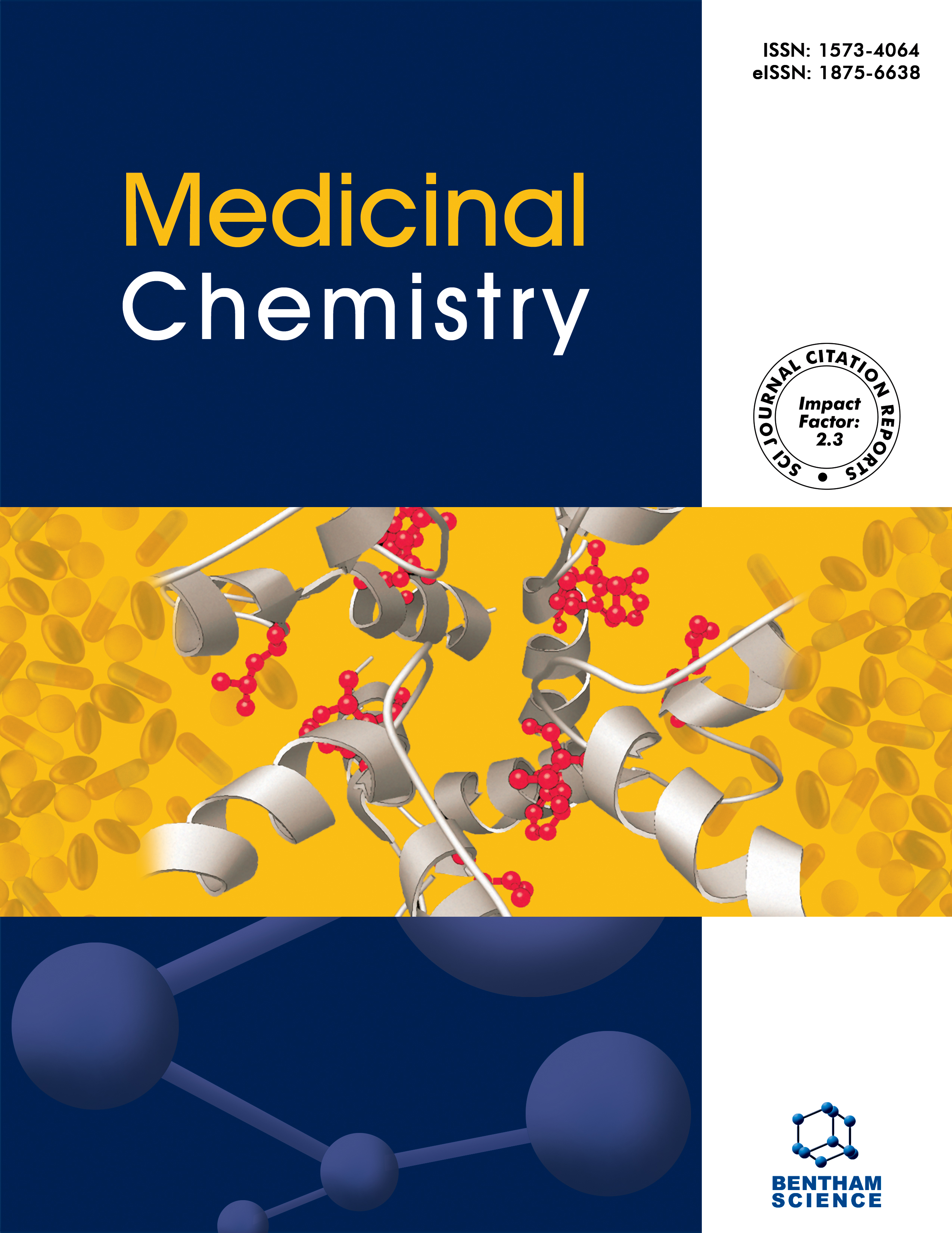- Home
- A-Z Publications
- Medicinal Chemistry
- Previous Issues
- Volume 14, Issue 8, 2018
Medicinal Chemistry - Volume 14, Issue 8, 2018
Volume 14, Issue 8, 2018
-
-
Crystal Structure of Mistletoe Lectin I (ML-I) from Viscum album in Complex with 4-N-Furfurylcytosine at 2.85 Å Resolution
More LessBackground: Viscum album (the European mistletoe) is a semi-parasitic plant, which is of high medical interest. It is widely found in Europe, Asia, and North America. It contains at least three distinct lectins (i.e. ML-I, II, and III), varying in molecular mass and specificity. Among them, ML-I is in focus of medical research for various activities, including anti-cancer activities. To understand the molecular basis for such medical appli Read More
-
-
-
Synthesis and Biological Evaluation of 12N-substituted Tricyclic Matrinic Derivatives as a Novel Family of Anti-Influenza Agents
More LessAuthors: Sheng Tang, Yu-Huan Li, Xin-Yue Cheng, Jin-Qiu Yin, Ying-Hong Li, Dan-Qing Song, Yan-Xiang Wang and Zhan-Dong LiuBackground: Influenza is still a serious threat to human health with significant morbidity and mortality, so it is desirable to develop novel anti-flu drug agents with novel structures. Objective: The main purpose of this research was to explore broad-spectrum anti-flu agents and provide antiviral stockpiles in response to potential future influenza pandemics. Methods: Fifteen novel 12N-substituted tricyclic matrinic derivatives were Read More
-
-
-
Homopiperazine Derived Female Controlled Vaginal Trichomonacidal Contraceptive: An Addition to Structure-Activity Relationship
More LessAuthors: Rahul B. Sreekumari, Bindu Saraswati, Shiju Chellan, Gopal Gupta and Nand LalBackground: In our previous work, several piperazine derived bis(dialkylaminethiocarbonyl) disulfides and disulfide esters of dithiocarbamic acid have been synthesized and evaluated for their spermicidal and microbicidal efficacy. These studies have provided some promising compounds for developing a dually active vaginal microbicidal contraceptive which is under pre-clinical stage. Objective: The main objective of this stud Read More
-
-
-
Antimicrobial Evaluation of Erythrinan Alkaloids from Erythrina crista-galli L.
More LessBackground: Several species of the genus Erythrina have been used as sedative, antidepressant, and anticonvulsant. Erythrina crista-galli is native to the Pampa Biome and is widely used for medicinal purposes. Erythrinan alkaloids exhibit a range of pharmacological properties. Objective: The aim of this study was to evaluate the basic fractions and the alkaloids isolated from E. crista-galli bark against a collection of bacteria an Read More
-
-
-
Synthesis of Nucleosides and Non-nucleosides Based 4,6-disubstituted-2-oxo-dihydropyridine-3-carbonitriles as Antiviral Agents
More LessBackground: Viral diseases are considered main threats that face the humanity worldwide. The emergence of new viruses like influenza viruses emphasizes the significance of designing novel antiviral drugs. Method: The aim of this work is to synthesize a new set of nucleoside and non-nucleoside cyanopyridine, characterized and evaluated for their in vitro antiviral properties against various strains. Conclusion: More of t Read More
-
-
-
Identification of New Chromenone Derivatives as Cholinesterase Inhibitors and Molecular Docking Studies
More LessBackground: Alzheimer's Disease (AD) is the leading cause of dementia among the aging population. This devastating disorder is generally associated with the gradual memory loss, specified by a decrease of acetylcholine level in the cortex hippocampus of the brain due to hyperactivation of cholinesterases (acetylcholinesterase (AChE) and butyrylcholinesterase (BChE)). Objective: Therefore, inactivation of Read More
-
-
-
2-Oxo-1,2,3,4-tetrahydropyrimidines Ethyl Esters as Potent β-Glucuronidase Inhibitors: One-pot Synthesis, In vitro and In silico Studies
More LessBackground: Glucuronidation is essential for the metabolism and excretion of toxic substances. β-Glucuronidase enzyme slows down the process of glucuronidation, and thus plays an important role in the on-set of colorectal carcinoma, and many other diseases. Inhibition of β- glucuronidase activity is thus identified as an important approach for the treatment of several diseases. Objective: Current study was aimed to synthesi Read More
-
-
-
Novel Hydroxamic Acids Incorporating 1-((1H-1,2,3-Triazol-4-yl)methyl)-3-substituted-2-oxoindolines: Synthesis, Biological Evaluation and SAR Analysis
More LessBackground: Histone deacetylases (HDAC) enzymes are emerging as potential targets for cancer treatments. In this study, several series of novel hydroxamic acids incorporating 1-((1H- 1,2,3-triazol-4-yl)methyl)-3-substituted-2-oxoindolines were explored. Methods: The compounds were designed using Autodock Vina program, then synthesized and evaluated in vitro and in silico for their inhibitory activity against HDACs. T Read More
-
-
-
Synthetic Diethyl 2,6-dimethyl-1,4-dihydropyridine-3,5-dicarboxylates Induce Apoptosis
More LessAuthors: Seunghyun Ahn, Youngshim Lee, Jihyun Park, Junho Lee, Soon Y. Shin, Young H. Lee, Dongsoo Koh and Yoongho LimBackground: The Hantzsch ester, diethyl 2,6-dimethyl-1,4-dihydropyridine-3,5- dicarboxylate, has been used as a hydride donor and its various biological effects have been reported. To identify chemotherapeutic agents with apoptotic effects, 21 diethyl 2,6-dimethyl-1,4- dihydropyridine-3,5-dicarboxylates were designed and synthesized; they have not been reported as apoptosis inducers thus far. Their structure-cytotoxicity r Read More
-
Volumes & issues
-
Volume 21 (2025)
-
Volume 20 (2024)
-
Volume 19 (2023)
-
Volume 18 (2022)
-
Volume 17 (2021)
-
Volume 16 (2020)
-
Volume 15 (2019)
-
Volume 14 (2018)
-
Volume 13 (2017)
-
Volume 12 (2016)
-
Volume 11 (2015)
-
Volume 10 (2014)
-
Volume 9 (2013)
-
Volume 8 (2012)
-
Volume 7 (2011)
-
Volume 6 (2010)
-
Volume 5 (2009)
-
Volume 4 (2008)
-
Volume 3 (2007)
-
Volume 2 (2006)
-
Volume 1 (2005)
Most Read This Month
Article
content/journals/mc
Journal
10
5
false
en


